Each year the slimy green weed blankets large parts of the bay – making it look more like a giant lawn than a beach.
The help keep Islanders informed about what is being done to tackle the problem the States have recently issued a guide to sea lettuce.
Here are ten facts about the weed, and what is being done to reduce it.
- Sea lettuce grows across the globe, not just in Jersey.
- Bathing water in St Aubins Bay is rated as good to excellent.
- Sea lettuce growth occurs in St Aubins Bay because it is shallow, enclosed and relatively warm. Its growth is also dependant on nutrients from outside St Aubins Bay and is also affected by sources including land run-off from streams that contain fertilisers and treated waste water from the water treatment works.
- The long-term target is to limit the growth of sea lettuce as much as possible by reducing nitrates from the land and the treatment works.
- Land-based nitrates are reducing. Farmers are using less fertiliser and better techniques. This is co-ordinated through the joint Action for Cleaner Water Group and the new Water Management Plan.
- The States are investing £75m in a new water treatment works to be completed in 2022. This will help reduce sea lettuce growth.
- The Infrastructure and Environment Departments are carrying out extensive research on sea lettuce, St Aubin Bays ecosystem and the ecologically important seagrass beds involving international experts.
- The Infrastructure Department moves sea lettuce at regular points throughout the summer. The movement is controlled by a licence to protect the ecosystem of the bay.
- The lower part of the beach at St Aubins Bay is an important ecological area and sea lettuce cant be moved from here without causing damage.
- There is no evidence that sea lettuce is disrupting St Aubins Bays ecosystem, including the important seagrass beds.






